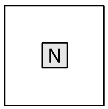5.A.i.b. Derivation of the 30" DEM from Source Materials
In 1994, NGDC (now NCEI) and DMA jointly designed a 30" DEM which DMA would contribute to NCEI for GLOBE. In the original design, a 10x10 array of 3" DTED Level 1 grid cells was processed to determine the minimum, maximum, and mean of 3"
values in each available 30" GLOBE grid cell. The data were restructured at NCEI for more convenient processing in raster geographic information systems (GIS), and released to the public as GLOBE Prototype Version 0.1 in 1995.
NIMA added a discrete (spot) 3" value to the data collection. This compilation is available at NIMA's Web site at the time of writing this document, and also on CD-ROM as GLOBE Prototype Version
0.5. The latter version has the files restructured for greater ease of use in a GIS.

|
Southwestern corner 3" value assigned to 30" grid cell.
Graphic describing georeferencing and sampling for DTED Level 0 discrete (spot) data (source/lineage category 1).
|
In addition, DMA had contributed coverage for most of the United States from an early precursor of DTED to USGS for public distribution. USGS calls these data "USGS 3 arc-second data." USGS resampled these data to 30" by
nearest-neighbor techniques, for incorporation into GTOPO30. These data form GLOBE 1.0 source/lineage category 5.

|
Cell-centered registration, nearest-neighbor 3" value used.
Graphic describing georeferencing and sampling for DMA/USGS 3 arc-second data to 30" for the U.S.A. (source/lineage category 5).
|
Similarly, DMA provided 30" grids for the conterminous U.S. (from an early version of DTED) for public distribution by NGDC (now NCEI) in the early 1980s. This 30" DEM included mean and spot (nearest- neighbor from 3") values. The spot data
form GLOBE 1.0 source/lineage category 4.

|
Cell-centered registration, nearest-neighbor 3" value used.
Graphic describing georeferencing and sampling for DMA/USGS 30" spot data for the conterminous U.S.A. and vicinity (source/lineage category 4).
|
As noted previously, USGS developed a 30" global DEM, called GTOPO30. GTOPO30 development involved specific groups assembling data for the different continents. Decisions made by these groups resulted in the following resampling methods:
-
For Africa (the first continent attempted), the resampling of 3" data used a “breakline” approach that favored ridges and valleys (Gesch and Larson, 1996). This was done to best fit with the ANUDEM- based methods (Hutchinson,
1989, 1996; Danielson, 1996) used for Digital Chart of the World gridding for Africa.

|
Cell-centered registration, breakline value computed.
Graphic describing georeferencing and sampling for DTED for Africa (source/lineage category 6).
|
-
For Eurasia, the resampling consisted of computing median values of non-oceanic locations within each 30" arc-second grid cell.

|
Cell-centered registration, 10x10 median value computed.
Graphic describing georeferencing and sampling for DTED for Eurasia (source/lineage category 2).
|
-
For the Americas, the resampling consisted of taking a ("nearest-neighbor") 3" value nearest the center of each respective 30" grid cell. Due to the georeferencing of the 30" GLOBE grid compared to that of 3" DTED
Level 1 data, there is a 3" DTED Level 1 grid cell-centered directly at the center of a 30" GLOBE cell. That value was used in the Americas.

|
Cell-centered registration, nearest-neighbor 3" value used.
Graphic describing georeferencing and sampling for DTED for the Americas (source/lineage category 3).
|
-
The DEMs for Eurasia and Africa were mosaicked along 39oN latitude, and 59oE longitude. The data were linearly blended along a 2-degree-wide zone centered along these lines. Thus at 40oN, median derivations were
used, at 38oN (west of 58oE) breakline methods were used exclusively, and at 39oN (west of 59oE) 50% weighting of both of these methods was used. This blending is category 7 in the source/lineage map.
Thus data originally from DTED sources have been contributed to GLOBE directly from NIMA. In addition, data were previously contributed by DMA for public distribution to USGS and NGDC (now NCEI) at various times during the past 20 years. The source map shown
in Section 11.E shows where different versions of these data were used in GLOBE Version 1.0.


Return to Report Introduction
|






